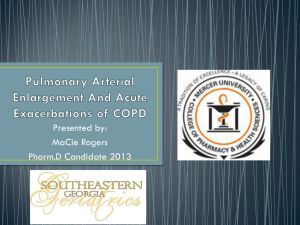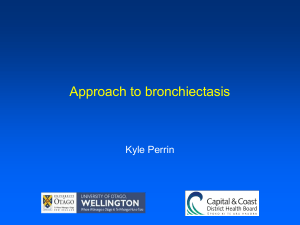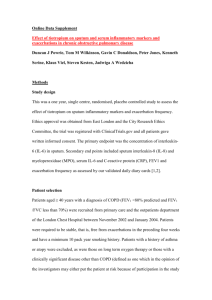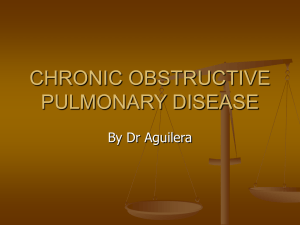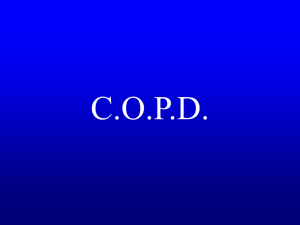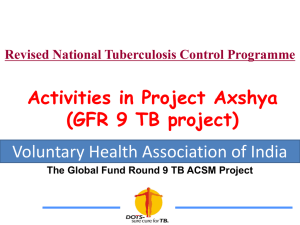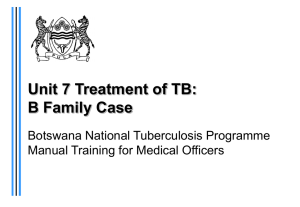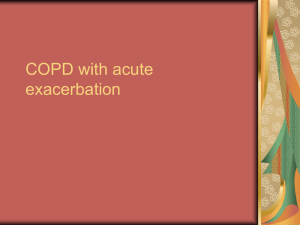New Strain Acquisition of Klebsiella spp, Enterobacter spp, and
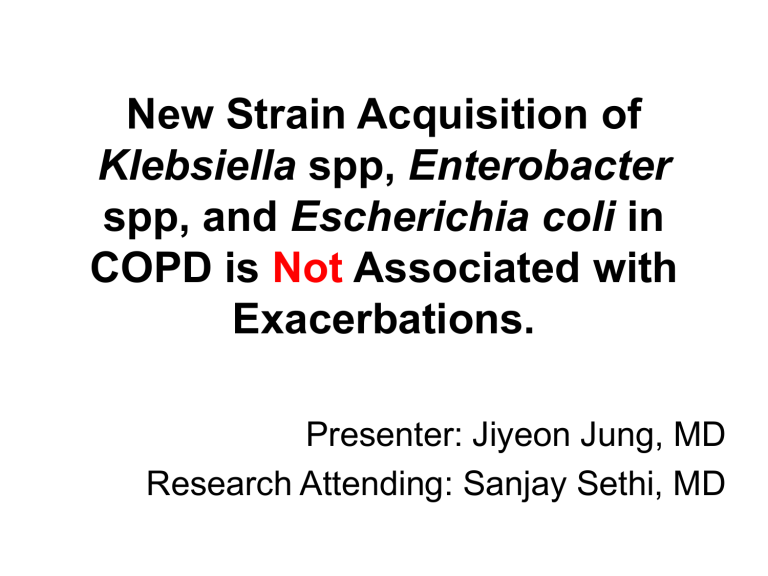
New Strain Acquisition of
Klebsiella spp, Enterobacter spp, and Escherichia coli in
COPD is
Not
Associated with
Exacerbations.
Presenter: Jiyeon Jung, MD
Research Attending: Sanjay Sethi, MD
A Case Vignette
• A 68-year-old former heavy smoker with a history of chronic obstructive pulmonary disease (COPD) presents to the ED with a two-day history of worsened shortness of breath and increased sputum.
Chest radiography shows hyperinflation and no acute infiltrates.
A Case Vignette
• House staff ordered sputum culture in ED.
• Sputum culture came back positive for
Klebsiella spp.
• How should this patient be treated?
History
• Since 1994 , the study has been conducted in WNY VA to reveal a relationship between bacterial infection and COPD exacerbation .
History
• The role of bacterial pathogens in COPD exacerbation was controversial .
• The rate of bacterial isolation from sputum was found to be similar in stable COPD and during exacerbations.
• On the basis of these observations, a seminal review in 1975 indicated that bacterial pathogens do not cause exacerbations and that their presence in sputum is due to chronic colonization.1
History
• New molecular, cellular, immunologic t echniques in the past two decades.
• Possible to differentiate strains of bacterial pathogens over time from the patients with molecular typing .
History
• Bacterial infections trigger COPD exacerbations.
• Four Major pathogens .
• A new bacterial strain plays a central role i n the pathogenesis of an Exacerbation.
History
• Example
Sputum culture(+) for H. influenza in stable phase
Sputum culture(+) for H. influenza in exacerbation
New strain of H. influenza in molecular typing.
History
• Sputum cultures are often not useful for identifying bacterial infection in patients with
COPD exacerbations.
• Gram stain and culture of sputum are similar during exacerbations and stable disease.
• They do not distinguish between true pathogens and colonizing flora .
• As per 2007 GOLD guideline, Sputum culture should Not be performed. 2
• Molecular typing
History
• Acquisition of a new strain of H. influenzae,
Moraxella catarrhalis, Streptococcus pneumoniae, or Pseudomonas aeruginosa is strongly associated with the occurrence of an exacerbation. 2,4,5,6,7
Background
• In severe COPD, Enterobacteriaceae
(Gram negative bacilli) are also isolated from sputum during exacerbations and stable disease .
8
• The dynamics of infection by these pathogens in COPD has not been examined.
Sethi S and Murphy T. N Engl J Med 2008;359:2355-2365
Hypothesis
• As four major pathogens.
• Klebsiella spp , Enterobacter spp , and
Escherichia coli
• If they are causative, there should be an association between strain acquisition of these pathogens and exacerbation.
Methods/COPD Study Clinic
• Prospective longitudinal study of COPD patients in an outpatient clinic
• 127 subjects enrolled from March 1994 to
Dec 2004
• Clinic visits monthly and suspected exacerbation
– At each visit:
– clinical information
– expectorated sputum sample
Method
• Exacerbation defined by the Global Initiative for Chronic
Obstructive Lung Disease (GOLD)
• Acute increase in symptoms beyond normal day-to-day variation . 2 This generally includes one or more of the following cardinal symptoms:
Cough increases in frequency and severity
Sputum production increases in volume and/or changes character
Dyspnea increases
• Constitutional symptoms, a decrease in pulmonary function, and tachypnea are variably present during an exacerbation, but the chest radiograph is usually unchanged. 2
Method/Bacterial Isolates
• Klebsiella spp, Enterobacter spp, and E. coli isolated from sputum were saved as frozen stocks at 70˚C.
Methods/Molecular typing
• Isolates of Klebsiella spp, Enterobacter spp, and E. coli were typed by Repetitive extragenic palindromic-
Polymerase chain reaction ( Rep-PCR ).
• Primers
REP-1RI: 5’-III ICG ICA TCI GGC-3’
REP-2I: 5’-ICGICT TAT CIG GCC TAC-3’
• PCR conditions (30 Cycles)
– Denaturation: 94C for 1min
– Annealing: 60C for 1 min
– Extension, 72C for 2 min
Methods/Molecular typing
• Electrophoresis to see banding patterns.
Methods/Molecular typing
• Each strain was categorized as preexisting or new on the basis of molecular typing.
• Strains not previously isolated from a subject were designated as new , whereas strains isolated previously were designated as preexisting .
Result
• Baseline Characteristics of the Patients
Age (mean
SD) 66.9
9.48
Years since diagnosis (mean
SD) 10.5
11.2
Smoking pack-years (mean
SD) in liters (mean
SD)
% predicted (mean
SD)
79.8
1.57
46.3
41.1
0.69
17.9 (15 - 99)
GOLD severity (number of subjects) 0 =5, 1 =1, 2 =45, 3 = 49, 4 = 27
Result
• 5100 clinic visits were completed by 127 patients, of which 931(18.2%) were exacerbation visits.
Result
• Sputum culture result
Pathogen Total isolates
(%)
Klebsiella spp 115 (2.3%)
Enterobacter spp
E. coli
114 (2.2%)
89 (1.7%)
New Strains/
Total isolates
(%)
51/115 (58.7%)
53/114 (60.4%)
19/89 (16.9%)
Result
• REP-PCR of Klebsiella spp
Result
• Time Line and Molecular Typing
Result
• Association between new strain acquisition and exacerbation
Pathogen
Klebsiella spp
Total isolates
(%)
New strains/ total isolates
(%)
115
(2.3)
51/115
(58.7)
Proportion of exacerbations in visits with new strain (%)
Proportion of exacerbations in visits without new strain (%) p value
(GEE)
8/51 (15.7) 912/5049 (18.1) 0.73
Enterobacter spp
114
(2.2)
53/114
(60.4)
12/53 (22.6) 919/5047 (18.2) 0.41
E. coli
All 3 species
89
(1.7)
19/89
(16.9)
3/19 (15.8) 928/5081 (18.3) 0.78
23/115( 26.5) 908/4985 (18.2) 0.62
Conclusion
• New strain acquisition does not appear to be a major mechanism of exacerbations of
COPD for Klebsiella spp, Enterobacter spp, and Escherichia coli .
A Case Vignette
• A 68-year-old former heavy smoker with a history of chronic obstructive pulmonary disease (COPD) presents to the ED with a two-day history of worsened shortness of breath and increased sputum.
Chest radiography shows hyperinflation and no acute infiltrates.
A Case Vignette
• House staff ordered sputum culture in ED.
• Sputum culture came back positive for
Klebsiella spp.
• How should this patient be treated?
Clinical implication
• Sputum culture should not have been done.
• The initial antibiotics regimen should target likely bacterial pathogens (H. influenzae,
M. catarrhalis, and S. pneumoniae in most patients). 8
Reference
• 1. Tager I, Speizer FE. Role of infection in chroni c bronchitis. NEJM 1975;292:563-71.
• 2. Global strategy for the diagnosis, managemen t and prevention of COPD, Global Initiative for C hronic Obstructive Lung Disease (GOLD) 2007.
• 3. Sethi S, Eschberger K, et al. Airway bacterial c oncentrations and exacerbations of COPD. Am J
Respir Crit Care Med 2007;176:356-61.
• 4. Sethi S, Evans N, Grant BJB, Murphy TF. New strains of bacteria and exacerbations of COPDN
EJM 2002:347:465-71.
Reference
• 5. Murphy TF, Brauer AL, Sethi S, Kilian M, Cai X, Less e AJ. Haemophilus haemolyticus: a human respiratory tr act commensal to be distinguished from Haemophilus in fluenzae. J infect Dis 2007;195:81-9.
• 6. Murphy TF, Brauer AL, Grant BJ, Sethi S. Moraxella c atarrhalis in COPD: burden of disease and immune resp onse. Am J Respir Crit Care Med 2005;172:195-9.
• 7. Murphy TF, Brauer AL, Eschberger K, et al. Pseudom onas aeruginosa in chronic obstructive pulmonary disea se. Am J Respir Crit Care Med 2008;177:853-60.
• 8. Sethi S, Murphy TF. Infection in pathogenesis and co urse of chronic obstructive pulmonary disease. N Engl J
Med 2008;359:2355-2365.
Acknowledgement
• Dr. Sanjay Sethi
